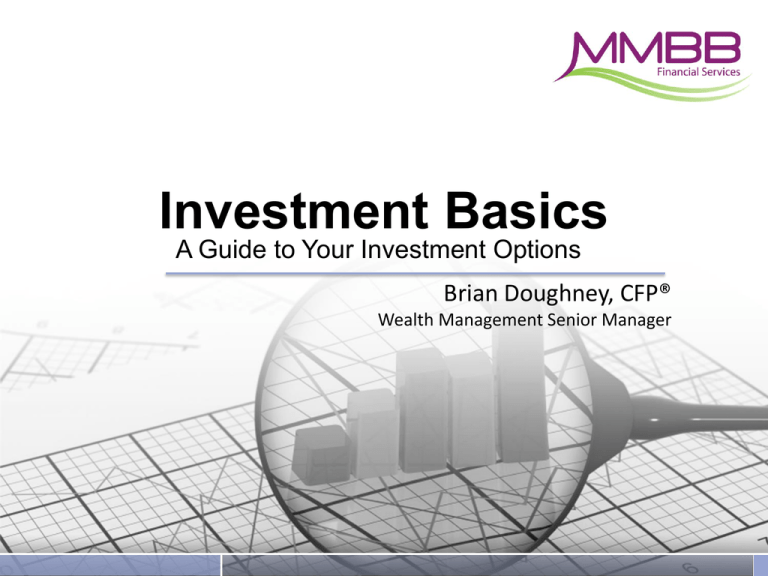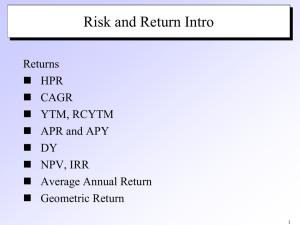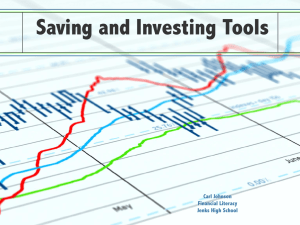Investment Basics Slide Show
advertisement

Investment Basics A Guide to Your Investment Options Brian Doughney, CFP® Wealth Management Senior Manager Investment Fundamentals What Is Investing? Speculating? Saving? Investing: A carefully planned and prepared approach to managing and accumulating money. Investment FundamentalsThe Effect of Inflation Purchasing Power of $200,000 at 3% Annual Inflation $108,759 $59,142 Investment FundamentalsThe Effect of Compounding Growth of Annual $5,000 Investments $395,291 • $5,000 invested annually at the end of each year • 6% annual growth rate • All earnings reinvested This is a hypothetical example and is not intended to reflect the actual performance of any specific investment. Investment fees and expenses, and taxes are not reflected. If they were, the results would have been lower. “Rule of 72” 72 ÷ Rate of Return = Years Needed to Double in Value Investment FundamentalsSooner is Better Don’t put off investing The sooner you start, the longer your investments have time to grow Playing “catch-up” later can be difficult and expensive $679,500 $3,000 annual investment at 6% annual growth, assuming reinvestment of all earnings and no tax $254,400 $120,000 This is a hypothetical example and is not intended to reflect the actual performance of any investment. Investment fees and expenses, and taxes are not reflected. If they were, the results would have been lower. Investment FundamentalsIdentifying Goals and Time Horizons Investment Goals Retirement Education Special purchase Financial security Short-term goals vs. long-term goals In general, the longer your investment horizon, the more risks you can afford to take Investment FundamentalsRisk Tolerance Ability of investment plan to absorb loss Personal tolerance for risk Aggressive Moderate Conservative Potential Return Investment FundamentalsRelationship Between Risk & Return Options & Futures Common Stock Preferred Stock Corporate Bonds Government Bonds CDs Stability Treasury Bills Risk Growth Risk-Return Tradeoff Income Investment OptionsTypes of Investments Cash alternatives Bonds Stocks Other investments Funds 403(b) plans and IRAs are not investments—they are tax-advantaged vehicles that hold individual investments Investment Options - Cash Alternatives Potential Return Low risk, short term, relatively liquid Examples of cash alternatives include: Cash Alternatives Risk Certificates of Deposit (CDs) Money market deposit accounts Money market mutual funds U.S. Treasury Bills (T-Bills) Investment Options - Cash Alternatives Advantages Predictable earnings Highly liquid Little risk to principal Disadvantages Relatively low returns May not keep up with inflation Potential Return Investment Options - Bonds Bonds Cash Alternatives Risk Loans to a government or corporation Interest typically paid at regular intervals Can be traded like other securities Value fluctuates Investment Options - Bonds Types of bonds include: U.S. government securities Agency/GSE bonds Municipal bonds Corporate bonds Investment Options - Bonds Advantages Disadvantages Steady and predictable stream of income Income typically higher than cash alternatives Relatively lower-risk (compared to options such as stock) Low correlation to stock market Risk of default Value of bond will fluctuate with interest rates Lower risk means lower potential returns (than stock, for example) Potential Return Investment Options - Stocks Stocks Bonds Cash Alternatives Risk Shares of stock represent an ownership position in a business Percentage of ownership determines your share of profit/loss Earnings may be distributed as dividends Shares of stock can be sold for gain or loss Investment Options - Stocks Common vs. preferred Categories: Small-Cap Mid-Cap Large-Cap Stock terminology: Growth stock Value stock Income stock Blue chip stock Investment Options - Stocks Advantages Historically, have provided highest longterm total returns Ownership rights Can provide income through dividends as well as capital appreciation Easy to buy and sell Disadvantages Poor company performance affects dividends / value of shares Subject to market volatility Greater risk to principal May not be appropriate for short-term Investment Options - Other Investments Real estate Stock options Futures, and commodities Collectibles Investment Options - Mutual Funds Your money is pooled with that of other investors Fund invests dollars according to stated investment strategy You own a portion of the securities held by the fund (instant diversification) Investment Options - Mutual Funds Potential Return International funds Stock funds Balanced funds Bond funds Money market funds Risk Three major investment categories: Money market funds Bond funds Stock funds Mutual funds fall all along the risk / return spectrum (e.g., balanced funds, international funds) Active vs. passive management Investment Options - Mutual Funds Advantages Diversification Professional management Small investment amounts Liquidity Disadvantages Value of shares can fluctuate daily Portion of fund dollars may be tied up in cash for liquidity needs Mutual fund fees and expenses Investment OptionsExchange-Traded Funds (ETFs) Most ETFs are based on an index Passive management may lower fund costs Can be traded throughout the day Investment Methods - Dollar Cost Averaging Invest same dollar amount at regular intervals over time You buy more shares when price is low, fewer shares when price is high Average cost of shares will be lower than average market price per share during your investment time period Five Hypothetical Investments $35 10 shares $30 12 shares $25 15 shares $20 $15 20 shares $10 30 shares $5 $0 Jan Feb Mar Apr May Average market price per share ($30 + $10 + $20 + $15 + $25) ÷ 5 = $20 Investor’s average cost per share $1,500 invested ÷ 87 shares bought = $17.24 This is a hypothetical example and does not reflect the performance of any specific investment. Dollar cost averaging can’t guarantee you a profit or protect you against a loss if the market is declining. Asset Allocation - Considerations Factors: Diversification Risk tolerance Timeframes Personal financial situation Liquidity needs Asset AllocationSample Allocation Model Conservative A conservative asset allocation model will tend to focus on preserving principal Cash Alternatives 25% Stocks 25% Bonds 50% These asset allocation suggestions should be used as a guide only and are not intended as financial advice. They should not be relied upon. Past performance is not a guarantee of future results. Asset AllocationSample Allocation Model Moderate Cash Alternatives 10% Bonds 40% Stocks 50% A moderate asset allocation model will tend to balance predictable income with potential growth These asset allocation suggestions should be used as a guide only and are not intended as financial advice. They should not be relied upon. Past performance is not a guarantee of future results. Asset AllocationSample Allocation Model An aggressive asset allocation model will tend to focus primarily on potential growth Aggressive Cash Alternatives 10% Bonds 15% Stocks 75% These asset allocation suggestions should be used as a guide only and are not intended as financial advice. They should not be relied upon. Past performance is not a guarantee of future results. The Role of a Financial Professional Help you determine your investment goals, timelines, and risk tolerance Create an asset allocation model Select specific investments Manage, monitor, and modify your portfolio The Fees of a Financial Professional Sales Charges A Share – up to 5.75% B Share – 6 year surrender charge C Share – 1% a year Annual Expenses A Share – 1.2% B Share – 1.8% C Share – 1.5% Managed Accounts Like a C Share Advisor gets 1%/year Annual Expense 1.5% Pro: Made up of multiple mutual funds Con: Very expensive How Fees Effect Your Portfolio Questions or Comments











